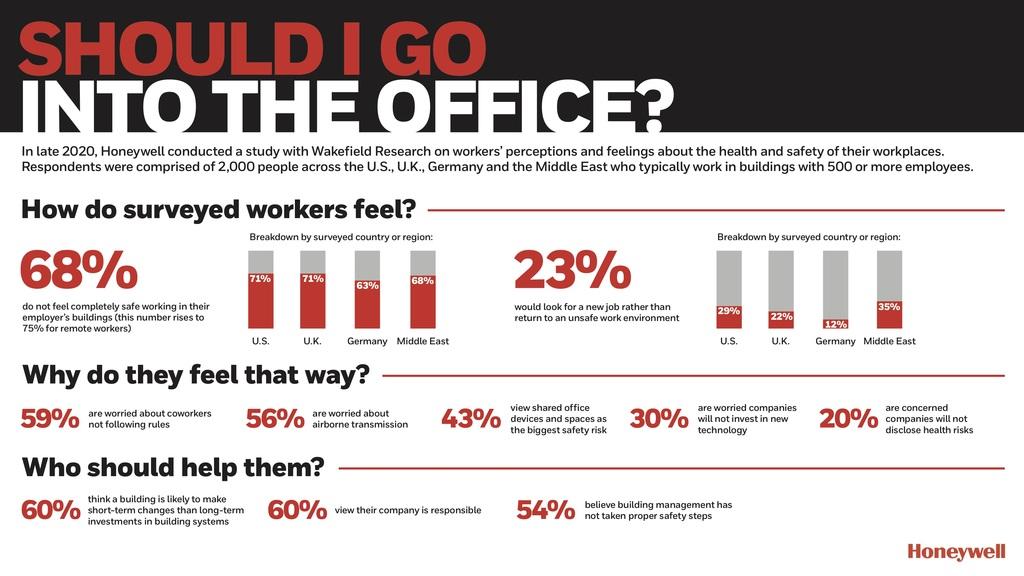The findings show that a staggering majority of the global workforce (68%) does not feel completely safe working in their employer's buildings. This number is even higher for those working remotely (75%), who are especially skeptical about the safety of work sites. In fact, nearly 1 in 4 remote workers (23%) would look for a new job rather than return to a site that did not implement necessary safety measures.
"Workers are keenly attuned to the steps employers are taking to make their workspaces safer and healthier, especially when it comes to air quality and adherence to safety guidelines, which wasn't previously a concern for some people," said Vimal Kapur, president and chief executive officer of Honeywell Building Technologies. "Air quality, for example, is not something that will be dismissed once we're on the other side of this pandemic. It will be essential to the occupant experience, and good air quality will help make workers feel more comfortable as they return back to their offices."
The surveyed workers' concerns echo the latest scientific research on the spread of COVID-19,1,2 with 56% of workers being more concerned about transmission through the air than through contact with a surface. In terms of what poses a bigger threat to their safety, more than 2 in 5 (41%) of those surveyed believe that buildings with outdated ventilation systems are more dangerous than co-workers not following safety guidelines.
More than half of surveyed workers (54%) agree that their building management has not taken the steps necessary to keep them safer on the job, and 60% believe their building is more likely to make short-term changes in response to the pandemic versus long-term investments in building systems. Surveyed workers are most worried that building management won't consistently enforce health and safety guidelines (42%), followed by worry that they won't consistently invest in new technology to make working in-person safer (30%).
"Many facilities have made changes to their procedures but have not invested in the building itself – and their occupants have noticed," Kapur said. "Workers are going to demand more from buildings in the future, and we're even seeing with these survey results that creating a healthier and safer environment will be a differentiator for staff retention and recruiting, and it may also impact long-term real estate value."
To return to work and feel safer, nearly 1 in 3 surveyed workers (31%) say updates to the air quality systems are critical, but only 25% of those on-site have seen such updates happen. Other top health and safety measures that surveyed workers want include protocols such as social distancing or mandatory masks (49%), followed by health screening protocols such as temperature checks (41%), enhanced cleaning procedures (40%), touchless door entries (31%) and technology for contact tracing (20%).
Honeywell's Healthy Buildings solutions help building owners improve their building environments, operate more cleanly and safely, comply with social distancing policies, and help reassure occupant safety. By integrating air quality, safety and security technologies along with advanced analytics, Honeywell's Healthy Buildings solutions are designed to help reduce potential risks of contamination and improve business continuity by monitoring both the building environment and building occupants' behaviours.
Highlights by Country
United States

United Kingdom
Germany
Middle East
To view the full report, please visit https://hwll.co/ys6hr.
MethodologyThe Honeywell survey was conducted by Wakefield Research (www.wakefieldresearch.com) among 2,000 workers in buildings of 500+ workers in the following markets: U.S. (500), U.K. (500), Germany (500) and the Middle East (500), between November 19th and December 1st, 2020, using an email invitation and an online survey. The data was weighted to ensure an accurate representation of countries' population size for the Middle East.
Results of any sample are subject to sampling variation. The magnitude of the variation is measurable and is affected by the number of interviews and the level of the percentages expressing the results. For the interviews conducted in this particular study, the chances are 95 in 100 that a survey result does not vary, plus or minus, by more than 2.2 percentage points from the result that would be obtained if interviews had been conducted with all persons in the universe represented by the sample.
References
1 CDC, Scientific Brief: SARS-CoV-2 and Potential Airborne Transmission, October 5, 2020 [Accessed December 15, 2020]
2 The Lancet, COVID-19 transmission—up in the air, VOLUME 8, ISSUE 12, P1159, DECEMBER 01, 2020 [Accessed December 15, 2020]









